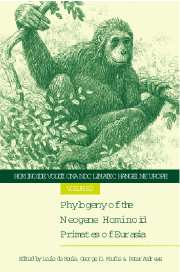 Hominoid Evolution and Climatic Change in Europe
Hominoid Evolution and Climatic Change in Europe Book contents
- Frontmatter
- Contents
- List of Contributors
- Acknowledgements: The European Science Foundation
- PART I: Chronology and environment
- PART II: Methods and phylogeny
- PART III Miocone hominoids: function and phylogeny
- 8 Eurasian hominoid evolution in the light of recent Dryopithecus findings
- 9 Functional morphology of Ankarapithecus meteai
- 10 African and Eurasian Miocene hominoids and the origins of the Hominidae
- 11 Phylogenetic relationships of Ouranopithecus macedoniensis (Mammalia, Primates, Hominoidea, Hominidae) of the late Miocene deposits of Central Macedonia (Greece)
- 12 Phylogeny and sexually dimorphic characters: Canine reduction in Ouranopithecus
- 13 Heterochrony and the cranial anatomy of Oreopithecus: some cladistic fallacies and the significance of developmental constraints in phylogenetic analysis
- 14 The late Miocene hominoid from Georgia
- 15 Forelimb function, bone curvature and phylogeny of Sivapithecus
- 16 Sivapithecus and hominoid evolution: some brief comments
- Index
14 - The late Miocene hominoid from Georgia
from PART III - Miocone hominoids: function and phylogeny
Published online by Cambridge University Press: 06 January 2010
- Frontmatter
- Contents
- List of Contributors
- Acknowledgements: The European Science Foundation
- PART I: Chronology and environment
- PART II: Methods and phylogeny
- PART III Miocone hominoids: function and phylogeny
- 8 Eurasian hominoid evolution in the light of recent Dryopithecus findings
- 9 Functional morphology of Ankarapithecus meteai
- 10 African and Eurasian Miocene hominoids and the origins of the Hominidae
- 11 Phylogenetic relationships of Ouranopithecus macedoniensis (Mammalia, Primates, Hominoidea, Hominidae) of the late Miocene deposits of Central Macedonia (Greece)
- 12 Phylogeny and sexually dimorphic characters: Canine reduction in Ouranopithecus
- 13 Heterochrony and the cranial anatomy of Oreopithecus: some cladistic fallacies and the significance of developmental constraints in phylogenetic analysis
- 14 The late Miocene hominoid from Georgia
- 15 Forelimb function, bone curvature and phylogeny of Sivapithecus
- 16 Sivapithecus and hominoid evolution: some brief comments
- Index
Summary
Introduction
More than half a century since the first announcement of the late Miocene discovery from Udabno (Gare-Kaxheti, East Georgia; Figure 14.1), remains of a hominoid-like primate were described by N.O. Burtshak-Abramovitz and E. G. Gabashvili (1945, 1950) as a new taxon – Udabnopithecus garedziensis. In the years that followed, other specialists in the field changed its taxonomy. Piveteau (1957) noted its close resemblance to the genus Dryopithecus, and later publications claimed that the hominoid ape from Udabno is actually synonymous with the species Dryopithecus fontani (Simons & Pilbeam, 1965; Szalay & Delson 1979; Andrews et al., 1996), although without any substantial discussion. Yet other opinions also were expressed (Reshetov, 1966, Nesturkh, 1968). In all the publications, the stratigraphic position of Udabnopithecus is rather approximate Middle/Late Miocene or Sarmatian.
A short description of the actual remains
A detailed examination of the hominoid remains from Udabno has convinced us that even though it shows significant similarities to Sivapithecus, a similarity which will be touched upon later, it is also very close in its attributes to Dryopithecus.
Udabnopithecus is represented by the right P4 and M1 imbedded in a maxilla fragment (Figure 14.2). During the extraction of the maxilla fragment, the P4 has been detached. It seems that the same happened earlier to M2 as evidenced by the remaining part of its alveolar cavity in the maxilla, and this tooth is now lost. The attrition of the teeth is slight to medium.
The P4 is oval shaped, rather squeezed in on its medial and distal sides (Figure 14.3). Its labial facet is shorter than the lingual, while the dorsal surface is less convex than the ventral.
- Type
- Chapter
- Information
- Hominoid Evolution and Climatic Change in EuropePhylogeny of the Neogene Hominoid Primates of Eurasia, pp. 316 - 325Publisher: Cambridge University PressPrint publication year: 2001
- 14
- Cited by


